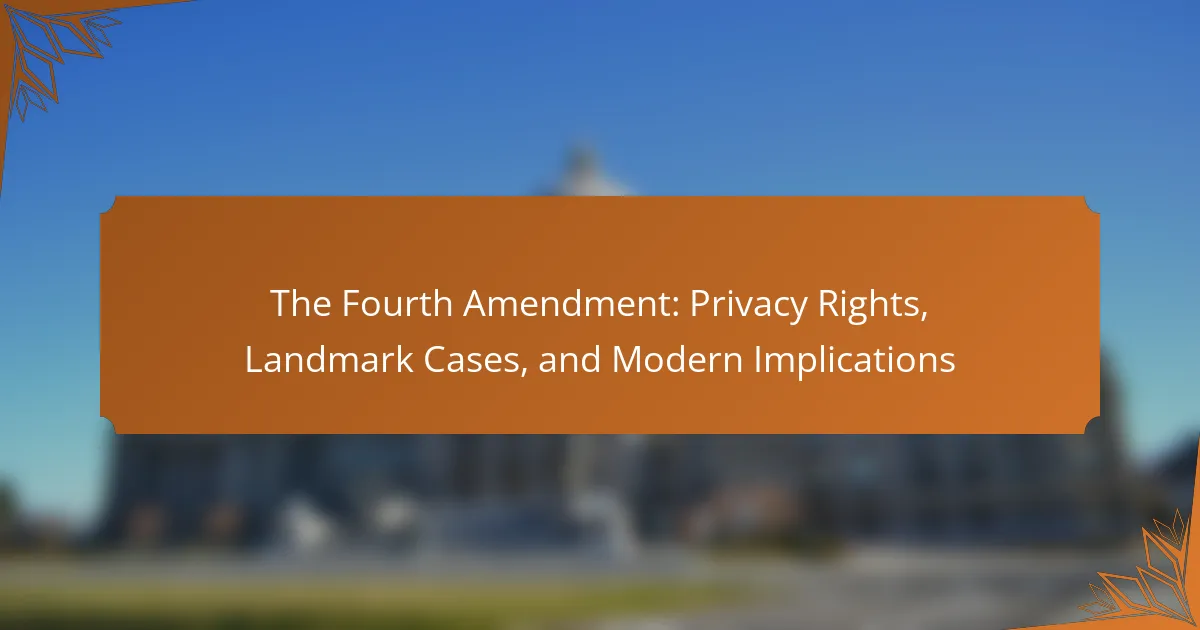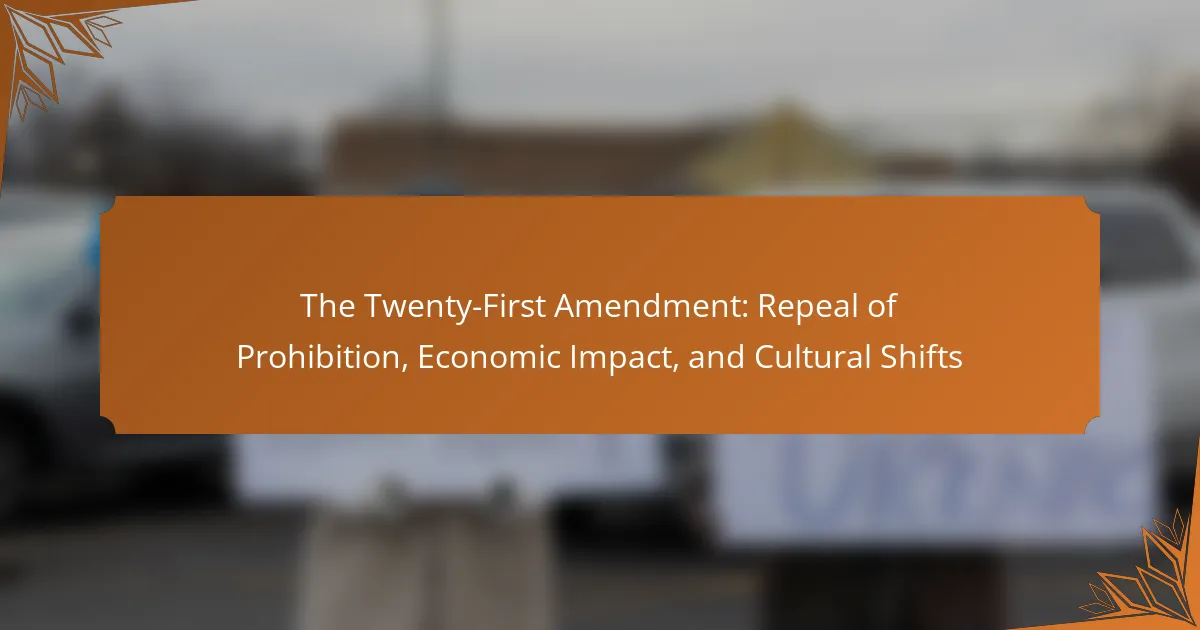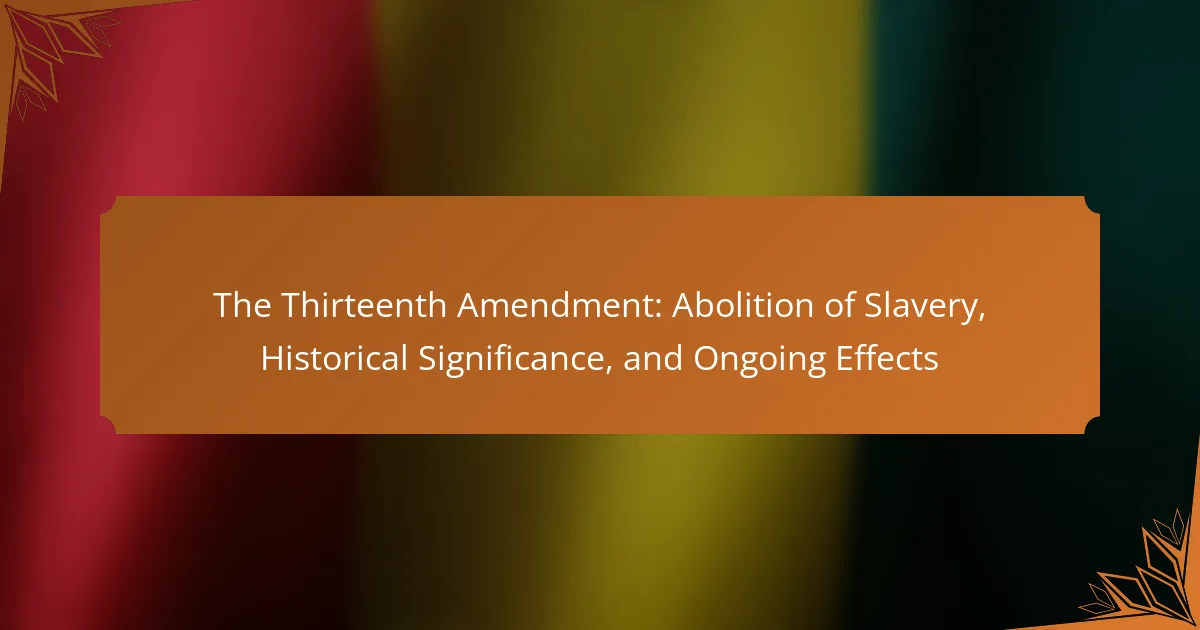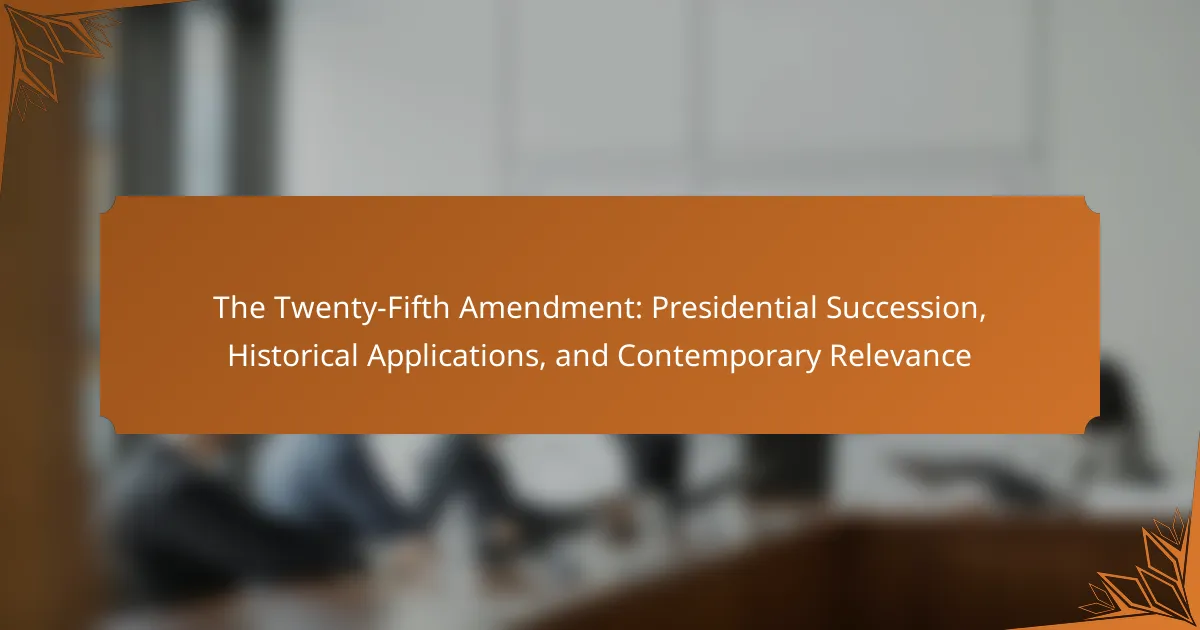The Fourth Amendment of the United States Constitution is a critical legal provision that protects citizens from unreasonable searches and seizures, thereby establishing the right to privacy in personal spaces and belongings. It mandates that law enforcement obtain a warrant grounded in probable cause prior to conducting searches, serving as a safeguard against government overreach. Landmark cases, such as Mapp v. Ohio, have played a significant role in reinforcing the application of this amendment within criminal law. The Fourth Amendment’s impact extends to contemporary legal standards and ongoing debates surrounding privacy rights, underscoring its foundational importance in American law.
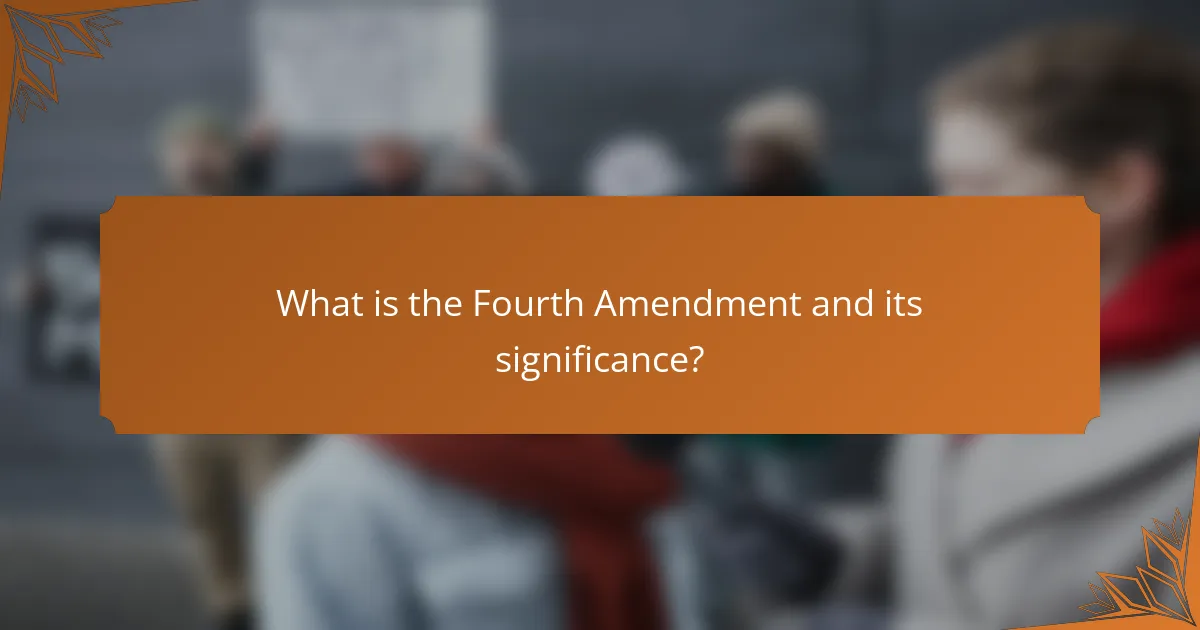
What is the Fourth Amendment and its significance?
The Fourth Amendment is a part of the United States Constitution that protects citizens from unreasonable searches and seizures. It establishes the right to privacy in one’s person, home, and belongings. This amendment requires law enforcement to obtain a warrant based on probable cause before conducting searches. Its significance lies in its role in safeguarding individual liberties against government overreach. Landmark cases, such as Mapp v. Ohio, have reinforced its application in criminal law. The Fourth Amendment is foundational to the concept of personal privacy in American law. It continues to influence modern legal standards and debates on privacy rights.
How does the Fourth Amendment protect privacy rights?
The Fourth Amendment protects privacy rights by prohibiting unreasonable searches and seizures. It requires law enforcement to obtain a warrant based on probable cause. This legal framework ensures that individuals have a reasonable expectation of privacy in their persons, homes, and belongings. Historical cases, such as Katz v. United States, established that privacy extends to conversations and communications. The amendment aims to safeguard citizens against arbitrary governmental intrusion. It reflects a fundamental principle of American law, emphasizing personal security. The Fourth Amendment serves as a crucial check on government power. Its application continues to evolve with advancements in technology, impacting privacy in the digital age.
What are the key components of the Fourth Amendment?
The key components of the Fourth Amendment are protection against unreasonable searches and seizures, and the requirement for warrants to be judicially sanctioned. This amendment safeguards individuals’ privacy rights. It establishes that warrants must be based on probable cause. The Fourth Amendment applies to all levels of government. It also protects against arbitrary governmental intrusions. Landmark cases have shaped its interpretation, such as Katz v. United States in 1967. This case expanded the definition of privacy under the amendment. Overall, the Fourth Amendment plays a crucial role in upholding civil liberties in the United States.
How does the Fourth Amendment apply to law enforcement practices?
The Fourth Amendment protects citizens from unreasonable searches and seizures by law enforcement. It requires law enforcement to obtain a warrant based on probable cause before conducting searches. This principle aims to safeguard individual privacy rights. The amendment also sets standards for the admissibility of evidence in court. Evidence obtained in violation of the Fourth Amendment may be excluded under the exclusionary rule. Landmark cases, such as Mapp v. Ohio, reinforce the application of this amendment. In Mapp, the Supreme Court ruled that evidence obtained illegally cannot be used in state courts. Therefore, the Fourth Amendment significantly shapes law enforcement practices and procedures.
What landmark cases have shaped the interpretation of the Fourth Amendment?
Landmark cases that have shaped the interpretation of the Fourth Amendment include Mapp v. Ohio, Katz v. United States, and Terry v. Ohio. Mapp v. Ohio established the exclusionary rule, which prevents illegally obtained evidence from being used in court. Katz v. United States expanded the definition of privacy, ruling that warrantless wiretapping violated the Fourth Amendment. Terry v. Ohio introduced the concept of stop-and-frisk, allowing police to stop and search individuals based on reasonable suspicion. These cases collectively influence how courts interpret privacy rights and law enforcement practices today.
Which cases have set important precedents for privacy rights?
The cases that have set important precedents for privacy rights include Katz v. United States, 389 U.S. 347 (1967). This case established the “reasonable expectation of privacy” standard. It ruled that wiretapping without a warrant violated the Fourth Amendment. Another significant case is Roe v. Wade, 410 U.S. 113 (1973). This case recognized a woman’s right to privacy in making medical decisions. Additionally, Lawrence v. Texas, 539 U.S. 558 (2003) invalidated laws against consensual same-[censured] activity, reinforcing privacy rights. These cases collectively shaped the legal landscape for privacy protections in the United States.
How did the rulings in these cases impact law enforcement procedures?
Rulings in landmark Fourth Amendment cases significantly reshaped law enforcement procedures. These decisions established clear guidelines for searches and seizures. For instance, the exclusionary rule emerged from Mapp v. Ohio, which mandates that evidence obtained illegally cannot be used in court. This ruling compelled law enforcement to ensure they have proper warrants or probable cause before conducting searches. Additionally, the ruling in Terry v. Ohio allowed “stop and frisk” procedures under reasonable suspicion but required officers to articulate their reasons. These rulings collectively enforced stricter adherence to constitutional protections, thereby enhancing accountability in law enforcement practices.
What are the modern implications of the Fourth Amendment?
The modern implications of the Fourth Amendment center around privacy rights in the digital age. This amendment protects individuals from unreasonable searches and seizures. Courts have interpreted it to apply to electronic communications and data. For instance, the Supreme Court case Riley v. California established that police must obtain a warrant to search a cell phone. This ruling highlights the need for privacy in personal digital devices. Additionally, advancements in technology have raised questions about surveillance practices. The use of drones and GPS tracking has challenged traditional interpretations of privacy. Overall, the Fourth Amendment continues to evolve in response to modern technological developments.
How has technology influenced Fourth Amendment protections?
Technology has significantly influenced Fourth Amendment protections by altering the way privacy is understood and enforced. The rise of digital surveillance tools, such as smartphones and GPS tracking, has expanded the scope of what constitutes a search. Courts have had to adapt traditional legal frameworks to address these technological advancements. For example, the Supreme Court case Carpenter v. United States (2018) ruled that accessing historical cell phone location data constitutes a search under the Fourth Amendment. This decision highlighted the need for a warrant in many digital surveillance scenarios. Additionally, technology has led to increased debates about privacy expectations in public spaces. As technology evolves, so do the interpretations and applications of Fourth Amendment protections.
What challenges do courts face in interpreting the Fourth Amendment today?
Courts face several challenges in interpreting the Fourth Amendment today. One significant challenge is the rapid advancement of technology. New technologies, such as smartphones and surveillance systems, complicate traditional notions of privacy. Courts must determine how these technologies interact with established legal precedents. Another challenge is the evolving societal expectations of privacy. Public attitudes towards surveillance and data collection are changing, which influences legal interpretations. Additionally, there is often a lack of clear statutory guidance. This ambiguity can lead to inconsistent rulings across different jurisdictions. The balance between national security and individual rights also presents a challenge. Courts must navigate complex cases involving law enforcement interests and personal freedoms. These factors collectively complicate the application of the Fourth Amendment in contemporary legal contexts.
How can individuals protect their Fourth Amendment rights?
Individuals can protect their Fourth Amendment rights by being aware of their legal protections against unreasonable searches and seizures. Understanding the legal framework is crucial. They should know that law enforcement typically requires a warrant based on probable cause to search personal property. Individuals can also refuse consent to searches when applicable. Documenting interactions with law enforcement can provide evidence if rights are violated. Seeking legal counsel when faced with potential violations is advisable. Staying informed about recent court rulings and changes in law can help individuals understand their rights better. Engaging in community discussions about privacy rights can foster awareness and advocacy.
What steps can citizens take to ensure their privacy is respected?
Citizens can take several steps to ensure their privacy is respected. First, they should use strong, unique passwords for online accounts. This reduces the risk of unauthorized access. Second, enabling two-factor authentication adds an extra layer of security. Third, citizens should be cautious about sharing personal information on social media. Limiting what is shared can protect privacy. Fourth, using encrypted messaging apps can secure private communications. Fifth, regularly reviewing privacy settings on devices and apps helps maintain control over personal data. Lastly, staying informed about privacy laws and rights, such as those protected under the Fourth Amendment, empowers citizens to advocate for their privacy.
How can awareness of the Fourth Amendment empower individuals?
Awareness of the Fourth Amendment empowers individuals by informing them of their rights against unreasonable searches and seizures. This knowledge helps individuals recognize when their privacy may be violated. Understanding the legal protections can lead to more informed interactions with law enforcement. Individuals who know their rights are better equipped to assert them in potentially compromising situations. Historical cases, such as Mapp v. Ohio, illustrate the importance of these protections. The ruling established that evidence obtained illegally cannot be used in court. This precedent reinforces the need for lawful procedures in searches. Consequently, empowered individuals can advocate for their privacy rights effectively.
The Fourth Amendment is a critical component of the United States Constitution that safeguards citizens from unreasonable searches and seizures, establishing the right to privacy in personal spaces. This article explores the significance of the Fourth Amendment, its key components, and landmark cases such as Mapp v. Ohio and Katz v. United States that have shaped its interpretation and application in law enforcement. Additionally, it addresses modern implications of the amendment in the context of evolving technology and privacy rights, while providing insights on how individuals can protect their Fourth Amendment rights and ensure their privacy is respected. The discussion emphasizes the ongoing relevance of the Fourth Amendment in contemporary legal standards and societal expectations of privacy.
